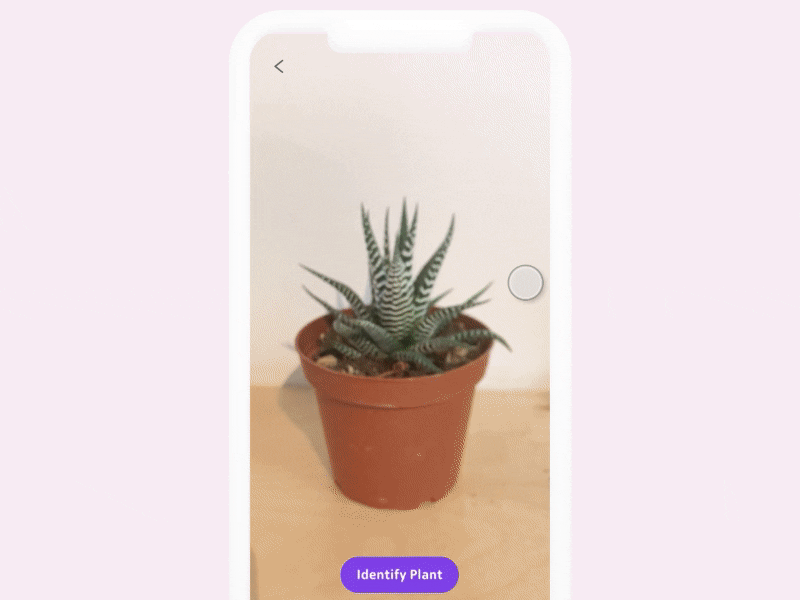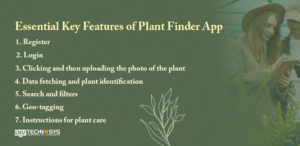Do you want to build a plant identification app like Plantsnap? Then you must read this blog. The use of mobile apps and smartphones has increased dramatically in today’s online world. Apps allow us to provide exclusive services, not just for shopping for clothes, groceries, and products. Today, there are apps that allow you to walk your dog, clean your home, or telemedicine.
One such app is the plant identification app. We have apps for many services so why not nature? The app will be loved by nature lovers and plant lovers. How frequently have you encountered a blossom or shrub without knowing its name?
Imagine if we could recognize the names of plants as soon as we see them. Applications for plant identification can be useful in this situation. Many professionals, including Botanists and Agriculturists, can use plant identification apps to help with research, education, and professional purposes.
This blog will answer your questions about plant identification apps and their functions. Continue reading to learn more about how to build a plant identification app and its features, benefits, and how they work.
What is a Plant Identifier App?

The Plant Identifier app allows users to snap a photo of any tree, plant, or flower and it will automatically identify it. This app is great for professional gardeners and landscapers who want to identify the plants they are working with, but don’t have the time or patience to research them.
It is convenient to build an app for Plant Identifier. You will need to have a mobile app developer who has experience in developing apps and an idea about what the app should do.
It’s great if you know what features your app should have. If you don’t know what features your app should have, then you can use mobile application solutions that have the resources and experience to develop a similar idea.
Why Would You Create A Plantsnap App?
PlantSnap has over 600,000+ plants stored in its searchable database. Just snap a photo of the shrub. The software can recognize the plant in a matter of seconds. PlantSnap can identify almost 90% of all tree species. You can therefore find nearly all the plant species that you will encounter on Earth with PlantSnap.
PlantSnap lets you identify plants by simply pointing your camera at the plant. Your camera should be focused on the plant. Boom!! Boom!
To view more information about the plant, users can click on the thumbnails. Swiping left or right will take them to more photos of the plant. Zooming in allows users to see more detail. The app can also determine whether you can buy the shrub you’re interested in online.
Any plant can be photographed and saved to your collection. If the app does not identify a plant correctly, you can email the image to PlantSnap experts to have it identified.
Professionals Who Can Use Plant Identification Apps
Now that you know why you must build a plant identification app like Plantsnap, it is time to see who can use this app.
#1. Gardners
Do you enjoy gardening? Plant identification apps can help you to learn more about plants, flowers, unknown species, seed and leaf types, as well as other trees, plants, flowers, seeds, and leaves. Many plant identification apps can not only identify plants but also provide detailed tips for gardening and farming to ensure better growth. The visual recognition system used in the plant identification app helps to identify tree species by taking pictures of leaves.
#2. Travelers
Most travelers love to travel and visit forests and woods where they can find new plants, trees, and flowers. The app allows travelers to explore more, and they can also learn about the use of different plants. This app can show travelers plants that have medicinal value even if they are injured.
#3. Farmers
Farmers can make a great income from plant farming. Plant identification software allows farmers to quickly access detailed information about plants, seeds, fruits, and other details. These applications give them detailed information on pests and other leaves. This enables them to make the right decisions about what crop to plant.
#4. Zoologists
Before considering a fruit or vegetable for an animal, zoologists can check the nutrition. Certain plants are edible for animals that can eat tree branches, flowers, and plants. Zoologists must ensure that animals are fed the correct amount of food to maintain their health.
#5. Botanists
Botany is a special education stream that allows students to recognize endangered plants, natural areas, and spices. Basic information about plants is available to students. It will be easier for students to learn about trees and flowers so that they can become botanists. Apps make it easier for users to ask questions and make their studies more enjoyable.
#6. Nature Lovers
Nature lovers are able to recognize the different shades of nature. Plant identification apps allow them to identify every detail about a plant. The plant identification app is able to identify many plants, trees, and flowers. This helps nature lovers.
Top Plant Identification App Like Plantsnap
There are several on-demand apps like Plantsnap but we have compiled the most widely and most bipolar app. These are some of the top plant identification apps that you can get inspired by:
1. PlantNet
This is a free plant identifier app that provides detailed information. It is well worth the effort thanks to its attractive photos and active plant identification, as well as suggestions from the Flora World.
2. PictureThis
This app is loved by many because it has robust features such as fast, accurate, rich content. It provides detailed information about plants and detailed descriptions. Additionally, it offers helpful tips for plant care and beautiful photos to enhance its effectiveness.
3. PlantSnap
This app offers a revolutionary way to identify plants using artificial intelligence and deep-learning techniques. It is unique in that it allows users to add information about plants along with their location. Users of Android and iOS devices can find information about plants using it.
4. LeafSnap
This is the best plant identification app that allows users to identify different types of trees and also allows them to identify them. One snap of a leaf or tree and you get accurate information back.
5. iNaturalist
A worldwide database available on the app can be used for research and environmental preservation. The app has a community that assists in improving the data. Users can also start a discussion and seek help from others if they have any questions.
You should now be able to identify plants and have more fun learning about them.
List of Key Features to Create an Online Plant Finder App

A plant identifier app is a great idea that helps users find the right information quickly. This is a list of essential features you should include when developing a plant identification application.
1. Register
This is where the user first interacts with your app. It should be simple and easy to onboard. You can either integrate the social signup or two-factor authentication methods to ensure prompt responses from users. These methods require the user to only enter their phone number, OTP, and password for verification of their profile.
2. Login
You will need to provide basic details such as your email ID and contact number. You can also use your social login details to log in to the app. A password reset link should be made available in case the password is forgotten.
3. Clicking and then Uploading the Photo of the Plant
It is easy to identify a plant using the plant identifier app. Simply click the photo of the leaf or plant using your smartphone’s camera and then upload it to the app.
4. Data Fetching and Plant Identification
The app platform will begin to search for relevant results after the user has uploaded the photo. Smartly integrated into the app, the image recognition feature allows for the retrieval of information about the plant from the record database. The exact match to the search query is returned, which allows users to explore more information about the plant.
5. Search and Filters
The search and filters feature allows users to find the exact type of plant they are looking for among the list of available plants. Multiple filters are available to provide more detailed information such as the plant’s family, scientific names, growth habits, and common names.
6. Geo-tagging
Geo-tagging allows users to quickly add the location of the plants. Later, other users can use the tagged location to find similar plants. To find a suitable image of a plant, the user can use the search engine to fill in all the coordinates.
7. Instructions for Plant Care
This is one of many useful and interesting features of the plant ID app. This helps to understand the environment and the basic nature of plants. It also provides information such as the requirements of soil, heat, and water that keep the plant healthy.
Technologies Required to Build Plant Identification App
It is crucial to choose the right technologies for any app. This helps to improve the app’s security, and scalability and allows for smooth operation. It’s critical to consider the technology infrastructure when developing an app that will be reliable for consumers. In order to build a plant identification app, you must integrate the tech stack and team mentioned above.
- Project manager
- Front-end developers
- Backend developers
- UI/UX designers
- Testers for quality analysis
These Technologies Will be Required to Create the Plant Identifier Application.
- Swift
- Kotlin
- CoreML
- MLKit
- Figma
- Cloud environment
- Tracking of location
How to Build Plant Identification App like Plantsnap?
A plant identification app is a rewarding and fun project that can help you learn more about machine learning and computer vision. Want to know how to make a mobile app like Plantsnap? These are the steps to help you build a plant identification app.
1. Define the Purpose and Scope of the App
Setting the foundation is key to building an app that identifies plants. Understanding your goals and objectives are also important. It is vital to determine carefully your app’s objective and potential audience. Are you looking to help people identify common plants or are you interested in rare and exotic species?
Once you have identified your goals, it is possible to begin to plan what information you will need and what features you should include in your app. You must ensure that your app addresses a real problem and solves it for users. It is vital that you must take enough time and deliberate about the goal and scope.
2. Collect Plant Data and Images
Collecting data and images about plants is the second step in building a plant identification app. This is an important step because it allows the app to have a complete list of plants that can be identified. You could work with botanists to learn more about different plant species.
It is possible to collect images of plants from a variety of sources, such as public databases or online resources. You could also go on field trips to photograph plants in their natural habitats. It is crucial that accurate, reliable data be collected in order to ensure the app provides accurate identification results.
3. Train the Machine Learning Algorithm
The third step to building a plant-identification app is to train the machine-learning algorithm. This is the most important step because it determines the accuracy of the app’s ability to identify plants.
The machine learning algorithm must be fed a large number of images and annotations. The algorithm will analyze the data and create a model capable of accurately classifying new images. This process is very computationally intensive and can take a while to complete.
To avoid bias in the algorithm, it is important to ensure that the training data includes a diverse range of plant species. Experts in the field are also able to help with the creation of a reliable and accurate algorithm. It is important to develop a model that can identify plants in all lighting conditions and angles.
4. Create the App
The fourth step of building a plant identification application is to develop the user interface and experience. This step involves designing a layout that is attractive, and intuitive and helps the user identify plants.
This could include choosing easy-to-read fonts and creating intuitive menus and buttons, as well as clear instructions about how to use the app. Hiring a hybrid app development company who are well versed in both native and web solutions would be beneficial. Additionally, think about how the software will function on the user’s phone.
If the app uses the camera to identify plants then you will need to make it easy to use and access. You may also need search functionality that allows users to search for specific characteristics or names of plants.
5. Test and Debug the App
To ensure the accuracy and functionality of the plant identification app, the fifth step is testing and debugging it. This is a step that requires human interaction. It involves checking the app for bugs and errors and making sure it works on different devices and operating systems. To ensure the accuracy of results and a smooth operation, the app must be tested thoroughly.
This can be done by having beta users or testers test it and give feedback. This is a crucial step to ensure the app’s quality and provide a pleasant experience for users when they use the app to identify plants. This step allows users to provide feedback that can be used to improve functionality and user experience, creating a more friendly experience.
6. Launch the App
Launching the app is the sixth step in building an app for plant identification. This can be both exciting and nerve-wracking. After you have successfully tested and debugged your app, it’s time to ensure that it’s available across multiple platforms in order for your target audience to access it.
Depending on the market you are targeting, you may launch it on iOS or Android. However, if you want to launch your app only on an android platform, then you must take help from android app development services.
Moreover, launching an app is only the beginning. To advertise it via social media, blogs, or other platforms, you’ll need a strong marketing plan. The first stage is only to launch your program. You will continue to improve it as you get feedback from users and collect new data.
7. Update and Maintain the App
The seventh step of building a plant-identification app is to keep it updated and maintained. This involves making sure that the app is up-to-date and relevant to current plant information and data.
Listening to users and addressing any issues or concerns is crucial. It is important to provide prompt customer support in order to build trust and loyalty. Users will be interested in your app if you release updates and add new features regularly. You can keep your app updated and improve its functionality to ensure your users are loyal to you and your brand.
A combination of creativity, technical skills, and persistence is required to build a plant identification app. These steps can be followed and you can create a plant identification app that is useful and valuable. A mobile app development company can assist in creating an app that can be used to help people learn more about the plants surrounding them.
Cost to Build Plant Identification App like Plantsnap
It is absurd to project the exact cost to build a plant identification app. There are several variables that can influence the cost. So let’s check out the most important factors:
- Application Features
A simple application will cost less. The app development costs will go up if you add advanced features like interactive games or other functions.
-
Application platforms
A plant identification app for one platform will be cheaper than an application for both Android and iOS. It will eventually cost twice as much.
-
The Location of an App Developer
Based on where they are located, the hourly rate for mobile app developers can vary. The hourly rate of app developers is generally lower in Asian countries such as India and doubles in Europe and the USA.
-
App Design
Complex applications will require more time to develop and increase the development cost. You can make a rough estimate after considering all of the features mentioned. The cost to develop a mobile app like Plantsnap with all features and functions will be between USD 8,000 and USD 16,000. If you need to integrate more advanced functions, the cost may rise to USD 25,000+.
Conclusion
You may be more prepared to make a decision after learning about the costs and features involved in developing a plant identifier app. This blog was created to inform readers about the cost to build a plant identification app and the features that can be included in an app.
It is a great idea to make money from it. You can hire an on-demand app development company that has extensive experience to help you turn your plant identification app idea into a reality.
Frequently Asked Questions
Q1. What is the time it takes to create an app like Plantsnap?
It is possible to take up to 7 months to create an app like Plantsnap. This depends on the complexity of the app and how many features are included, the size of your development team, and what development methodology you use. For a basic version, it would take around 4-6 months, while for more complicated versions with more integrations and features, it could take up to 8-10 months or more.
Q2. How does a plant identifier app work?
The app allows you to take photos of plants. It then compares your image with a database of plants and gives you a list of matches, along with details about each plant.
Q3. How do I hire a developer for apps like Plantsnap?
You can create a project description and post it on job boards or freelancer sites to hire dedicated programmers for a PlantSnap app. You should look for mobile app developers who have experience in areas such as image recognition and machine learning. To assess candidates’ expertise and abilities, speak with them and review their portfolios. Before hiring a dedicated developer, it is essential to discuss the project timeline, budget, and expectations in terms of communication.
Q4. How does the App Identify Plants?
The app compares the photo you take to a list of plants using image recognition technology and machine-learning algorithms. The app analyzes the plant’s characteristics, including the shape and colors of its leaves and flowers. It matches these photos to its database to identify the species.
Q5. How are apps for plant recognition created using artificial intelligence?
AI is integrated into plant identification apps, which helps to fight invasive species and active identification of applications. AI technology was integrated into apps to recognize many plant types.















